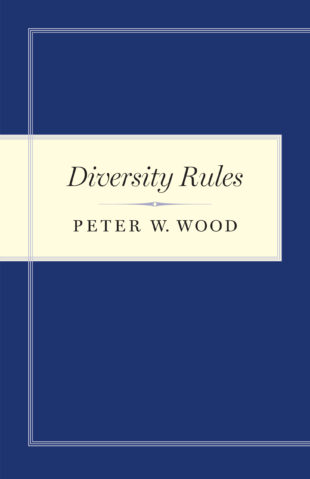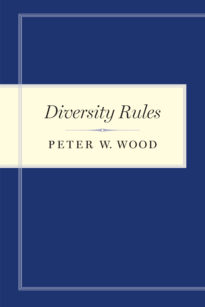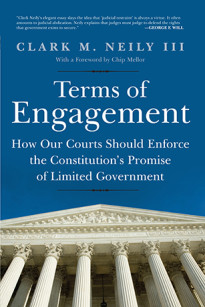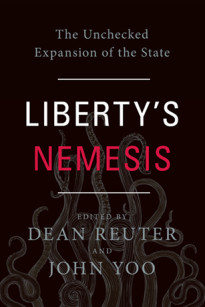If I were to write another long book on diversity, I would take as my model Alexis de Tocqueville’s Democracy in America and title it Diversity in America. And I would set out to capture the transformation of a republic founded on the ideals of freedom and equality into a regime scared into submission by the fear of being called a “racist.” This all-purpose term of opprobrium is diversity’s way of silencing dissent and forcing its way ahead wherever its leaders choose to take it.
But this isn’t that book. Instead, it is my commentary on what has happened since 2003, when I authored Diversity: The Invention of a Concept.
Diversity is the grown child still living at home. He is old enough by now to move out, but he just hasn’t gotten around to it. Moreover, the United States Supreme Court ruled in 2003 that he could stay another twenty-five years. Let’s see: that would be June 2028, when he’ll be exactly fifty years old. I suspect at that point he will want to stay put.
He will be fifty because the diversity doctrine as we have come to know it was born at the Supreme Court in June 1978. That’s when the Court handed down its decision in the case of Bakke vs. The University of California, and Justice Lewis Powell freelanced an opinion that put diversity on the map. Powell said that the Medical School at the University of California Davis had no business offering racial preferences to some applicants in an effort to right historical injustices. But if the University had justified its racial preferences as a way to achieve the educational benefits of diversity, Powell, for one, might have reached a different conclusion.
No other Justice agreed with Powell on this point, and his opinion could easily have rolled off the table like a loose marble to be swept away when the cleaners arrived. But as it happened, colleges and universities were looking for a new way to justify the use of race in college admissions. They feared the Supreme Court would go beyond Bakke and rule all racial preferences unconstitutional.
That put the concept of “diversity” into play in American higher education. By the early 1980s, campus offices of “affirmative action” were rapidly being renamed diversity offices. Moreover, Powell’s awkwardly written opinion gave way to a more expansive version of the idea. The opinion, after all, stereotyped members of minority groups as walking billboards for the views he imagined were characteristic of those groups. Black students were supposed to show up enunciating “black viewpoints” for the edification of non-black students. Powell explicitly justified favoritism toward black students as a way to enhance the educational experience of white students. He rejected entirely the idea that such favoritism could be founded on anything else, such as compensating minority students for historic grievances or overcoming a history of racial discrimination.
Powell’s reasoning and his rhetoric were of limited use to the evangelists of diversity, but they swooned over the basic concept: a simple, memorable word that could stand for all sorts of things besides racial preferences in admissions. Diversity, for example, could also mean respect for the world’s many cultures and revamping the curriculum in that light; hiring faculty members who “look like” the students; and even segregating students into racial group—the better to serve their supposed group needs.
By the mid-eighties, diversity was the hottest idea in American education, and it was poised for breakout into the culture at large. In 1987, a misread report from the Hudson Institute stampeded corporate America towards the diversity cliff. The report seemed to say that by the turn of the century, standard-issue white workers would be a rapidly dwindling minority. The future belonged to those companies that got with the diversity program immediately. Overnight a new profession of “diversity consultants” was born.
If you have read Diversity: The Invention of a Concept, you have already enjoyed the scenic tour of what happened during those years. The book left off on the eve of the Supreme Court’s decision in another race-preferences-in-college-admissions case, Grutter v. Bollinger. I dared hope at the end of the book that the Court would ring down the curtain on twenty-five years of Powell-inspired diversity folly. Justice Sandra Day O’Connor, however, disappointed me. She not only promised another twenty-five years of diversity folly, but she also gave the concept something that Powell had been unable to do: the kiss of legitimacy of a majority Supreme Court decision.
Liberty, Equality, Diversity
O’Connor’s opinion has been ably dissected by many others, including four of her own colleagues on the Court. As with Powell’s opinion in Bakke, however, the significance of O’Connor’s validation of the diversity end-run on the Equal Protection clause of the Fourteenth Amendment far exceeds its particular legal applications. Grutter permits colleges and universities to apply racial preferences in student admissions provided they dress the preferences in suitable camouflage as the pursuit of diversity. But Grutter also gave ferocious new power to what we now call identity politics.
Diversity before Grutter was a creed ardently promoted by campus activists and increasingly taken to heart by college administrators. It was also a catchy idea that had been taken up without any serious reflection in many domains of American culture. Business, entertainment, sports, churches, and consumers were all attracted to aspects of the diversity doctrine. But diversity was still something new and a little unfamiliar.
Americans understand that our nation was founded on the principles of liberty and equality. Americans also understand that liberty and equality sometimes conflict. Perfect liberty seldom produces perfect equality. Some use their liberty to get rich. Some use their insistence on equality in a manner that cuts against others’ liberties. Americans have long struggled to find the best ways to accommodate both ideals. Diversity, however, is something different: a third thing that in crucial ways undermines both liberty and equality.
Diversity undermines liberty because it takes away our basic freedom to decide for ourselves who we are. To be assigned to a racial or ethnic group that represents and supposedly speaks for me is to obstruct my right to free expression and my ability to craft my own identity. Or if self-definition doesn’t match your sense of liberty, think of diversity as something that restricts our choices and opportunities by imposing a grid of unchosen racial, ethnic, or sexual group alliances. Diversity demands that individuals inwardly believe in and outwardly support specific views about race and gender in order to win acceptance in society.
Diversity also undermines equality, because it strips from the individual equality before the law and substitutes the pseudo-equality of group rights. These aren’t small erosions of traditional rights, but major efforts to bulldoze those rights. Every time an American is asked to check a box on a form declaring himself white, black, Hispanic, Native American, or something else, he is permitting someone else to make decisions based on his race. He is sacrificing a bit of his autonomy. When a student applies for admission to college as an African-American or a construction company applies for a government contract as minority-owned, the student or the company is locked into the world of group identity. Calculations of self-interest henceforth have to be filtered through group interest.
To be sure, group interests were not invented in 1978, or in 2003. Our Founders, and many generations since, were well aware of the advantages that could accrue to people based on ethnic or tribal allegiance, and the disadvantages to the nation as a whole if such allegiances could run unchecked. Ethnic politics have always been with us. The diversity doctrine, however, turns what almost everyone agreed was a weakness of American democracy into a supposed strength. We are asked—endlessly—to “celebrate” diversity. And the diversity we are asked to celebrate isn’t the mere abundance of social and cultural differences subsumed into the national fabric, but the differences that cannot and should not be subsumed: the group identities that remain primary loyalties.
Group interests weren’t invented yesterday, but many of the groups claiming group interest are novelties, created by combining and repackaging various discontents. How did the great variety of Latin American cultures crystalize as “Latinx” people? Where in history did the congeries of sexual nonconformists ever before convene as LGBTQ? The invented quality of many of the grievance groups isn’t incidental to diversity. The logic of the doctrine demands it find new frontiers: new groups that parcel themselves into ever more implausible categories to turn status into power. If a brand new category is hard to invent, diversity advocates can combine existing ones. This goes under the heading “intersectionality.” If being black doesn’t produce sufficient diversity points, try black and female, or black, female, and handicapped. Intersectionality multiplies the opportunities for grievance.
Diversity is all about factionalism, and about turning factionalism from a necessary evil to a positive good. Diversity advocates, or “diversiphiles” (I called them this in 2003 and the word has had a modest success in the years since), are often eager to assert they support a larger unity made up of disparate parts. When speaking in this mode, diversiphiles have two favorite metaphors. Diversity is like a quilt, pieced together of many parts that do not lose their distinctiveness when stitched together. Or diversity is like a salad bowl, in which the ingredients are tossed together to create a healthy whole.
These invocations of the unity that diversity can inspire have their tactical purposes and their psychological appeals. Tactically, they help to fend off the criticism that diversity is a justification for a racial spoils system. Psychologically, they offer the winsome prospect of good feeling among identity groups that might seem not all that friendly to one another. Diversity sells better as a benign invitation to an all-for-one-and-one-for-all picnic in the park, where we sit on the diversity quilt and eat our vegetables together. Above all, diversity is not a “melting pot.” The effort to assimilate outsiders to mainstream American culture is, in the eyes of diversiphiles, an offense against their cultural distinctiveness.
The quilt/salad bowl kindergarten version of diversity, alas, is pretty far from the real thing. Mostly what diversiphiles do is assert their grievances. Each group in the ever-expanding diversity alliance has its own history of injustices visited on past and sometimes current members. The legacy of these injustices transcends time and space. The hurt inflicted on people sold into slavery by West African kingdoms in the seventeenth century wears on the souls of distant descendants in the twenty-first century. The oppression experienced by women under millennia of “patriarchy” resurfaces in the lives of successful women today. The fully public and accepted gay individual of today is invited to claim ownership of the suffering of his closeted counterparts of the 1950s. Every “diverse” group has its story, its fallen heroes, and its landmarks. And from this soil grows resentment and demands for restitution.
Of course, some individuals who could play the diversity game decline the invitation. They choose not to be professional victims.
Diversity can, when convenient, pretend to be nice, but at its core it is a grudge match. It stands in deep opposition to American culture, which it treats as compromised and corrupt. The “winners” don’t deserve their “privilege.” They gained their advantages by means of malice and exploitation. Diversity is the summons to the exploited to set matters right. And it is a counsel to the heirs of the exploiters that they have one last chance to make amends.





